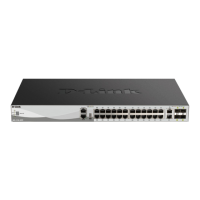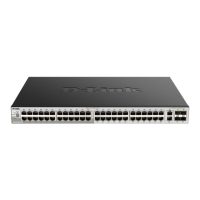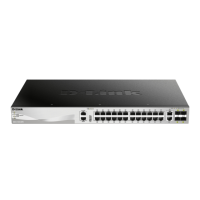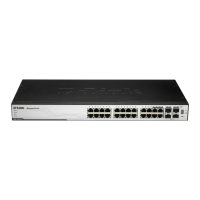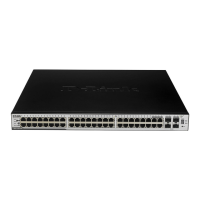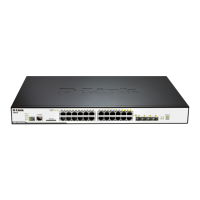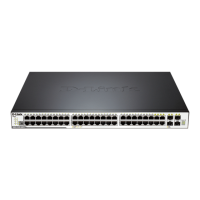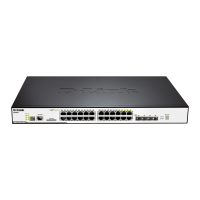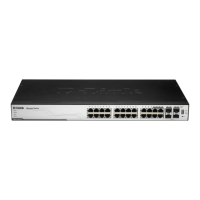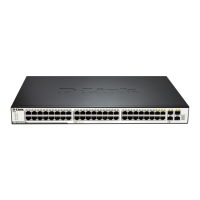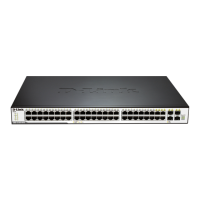Do you have a question about the D-Link DGS-3130-30TS and is the answer not in the manual?
Identifies the intended audience for this reference manual, assuming prior knowledge of networking principles.
Lists other D-Link documents for configuring and troubleshooting the Switch.
Explains conventions used in the manual for formatting, symbols, and UI elements.
Defines indicators used in the manual to highlight important information, potential damage, or safety warnings.
Describes the available management platforms for the Switch: CLI, SNMP, and Web UI.
Provides instructions on how to access the Switch's Web User Interface using a web browser.
Explains the functionality and benefits of the Web UI for managing the Switch.
Details the four distinct areas of the main Web UI window and their functions.
Displays basic information about the Switch, such as device type, MAC address, and software versions.
Allows configuration of system name, location, contact, and management interface settings.
Configures environment trap settings and temperature threshold settings for the Switch.
Provides settings for configuring port speed, duplex, MDIX, and flow control.
Details Power over Ethernet (PoE) features, classifications, and system settings.
Covers settings for system log, discriminator, server, and attack logs.
Configures clock settings, time zones, and SNTP for time synchronization.
Enables or disables the logging of commands executed via the CLI.
Allows creation, updating, and viewing of user accounts and active sessions.
Configures whether to save password encryption in the configuration file.
Enables or disables the password recovery feature for user accounts.
Configures the login method for management interfaces like Console, Telnet, and SSH.
Covers SNMP global settings, traps, views, communities, groups, engine ID, users, and hosts.
Configures Remote Monitoring (RMON) settings for alarms, statistics, history, and events.
Configures Telnet and Web server states, ports, and source interfaces.
Configures session timeout settings for Web, Console, Telnet, and SSH sessions.
Covers DHCP server, relay, class settings, IPv6 DHCP, and auto-configuration.
Configures global DNS settings, name server settings, and host settings.
Configures IP TFTP source interface settings.
Manages the Switch's file system, including copying and creating directories.
Covers physical stacking settings, bandwidth, and virtual stacking (SIM).
Configures the D-Link Discovery Protocol (DDP) settings for device discovery.
Configures Simple Mail Transfer Protocol (SMTP) settings for email notifications.
Configures global settings for PPPoE Circuit ID Insertion.
Configures scheduled reboot settings for the Switch.
Manages SD card backup and execute settings for configuration storage.
Covers Forwarding Database (FDB) settings, including static FDB entries.
Configures global MAC address table settings, including aging time.
Configures MAC notification settings for address changes and trap states.
Covers VLAN settings including 802.1Q, 802.1v Protocol VLAN, GVRP, Asymmetric VLAN, MAC VLAN, and VLAN Interface.
Configures super VLAN settings, used to aggregate multiple sub-VLANs into an IP subnet.
Configures properties and MAC settings for auto surveillance VLAN.
Configures global and port settings for Voice VLAN, including OUI settings.
Configures private VLAN settings, including association and mapping.
Covers Dot1q Tunnel and VLAN Mapping settings for tunneling VLAN traffic.
Covers ARP elevation, aging time, static ARP, proxy ARP, and ARP table settings.
Configures gratuitous ARP settings for detecting duplicate IP addresses and preloading ARP cache.
Configures IPv6 neighbor settings, including interface VLAN, IPv6 address, and MAC address.
Manages IPv4 and IPv6 interfaces, including loopback and null interfaces.
Configures IP forward protocol settings and IP helper addresses for UDP broadcast packets.
Configures IPv4 static and default routes, including IP address, mask, gateway, and backup state.
Displays and configures the IPv4 route table settings.
Configures IPv6 static and default routes, including IPv6 address, interface name, and backup state.
Displays and configures the IPv6 route table settings.
Configures route preference settings, which represent the route's trust rating based on distance.
Configures Equal-Cost Multi-Path (ECMP) routing settings for load balancing.
Covers RIP settings including global, redistribution, and interface configurations.
Configures Routing Information Protocol Next Generation (RIPng) settings for IPv6.
Covers OSPFv2 and OSPFv3 settings, including process, distribute list, GR helper, passive interface, area, interface, virtual link, LSDB, neighbor, and host route settings.
Manages IP multicast routing protocols, including IGMP and PIM settings.
Configures route map settings for filtering imported routes.
Configures policy route settings for traffic routing based on defined policies.
Configures Virtual Router Redundancy Protocol (VRRP) settings for high availability.
Configures VRRP version 3 (VRRPv3) settings for virtual router redundancy.
Includes settings for Port Default CoS, Port Scheduler Method, Queue Settings, CoS to Queue Mapping, Port Rate Limiting, and Queue Rate Limiting.
Covers DSCP Mutation Map, Port Trust State, DSCP CoS Mapping, CoS Color Mapping, DSCP Color Mapping, Class Map, Aggregate Policer, Policy Map, and Policy Binding.
Configures Weighted Random Early Detection (WRED) profiles and queues for congestion management.
Guides the user through creating or updating ACL access lists, including packet type and rule addition.
Displays and configures ACLs, ACL rules, and settings for IP, IPv6, MAC, and Expert ACL types.
Configures ACL interface access group settings for controlling access on specific interfaces.
Configures ACL VLAN access map settings to control traffic based on VLAN IDs.
Configures ACL VLAN filter settings to control traffic based on VLAN IDs.
Configures CPU ACL settings to filter traffic destined for the CPU.
Configures global, port, and address entry settings for port security.
Covers 802.1X global and port settings, authentication sessions, statistics, and diagnostics.
Configures global AAA settings, application authentication, accounting, and authentication methods.
Covers RADIUS global settings, server settings, group server settings, and statistics.
Covers TACACS+ global settings, server settings, group server settings, and statistics.
Configures IP-MAC-Port Binding (IMPB) settings for IPv4 and IPv6.
Configures DHCP server screening settings globally, per port, and per VLAN.
Configures ARP spoofing prevention settings to drop packets with mismatched MAC addresses.
Configures BPDU attack protection settings for ports, including modes like Drop, Block, and Shutdown.
Configures MAC authentication settings for user authentication via MAC address.
Manages Web-based Access Control (WAC) settings, including web authentication and port settings.
Covers Guest VLAN, global, port, and session information for network access authentication.
Configures the Safeguard Engine to protect the Switch CPU from attacks.
Configures trusted host settings by associating ACLs with specific host types.
Configures traffic segmentation settings to restrict Layer 2 packet forwarding.
Configures storm control settings to prevent broadcast, multicast, and unicast storms.
Configures Denial-of-Service (DoS) attack prevention settings for various attack types.
Covers SSH global settings, host key management, server connection, and user settings for secure remote access.
Configures SSL global settings, service policies, and crypto PKI trustpoints for secure communication.
Configures Secure File Transfer Protocol (SFTP) server settings for secure file transfers.
Covers CFM settings, including global settings, domain name, loopback test, linktrace, packet counter, counter CCM, MIP CCM table, MEP fault table, and CFM extension.
Performs cable diagnostics to test copper cables and determine quality and error types.
Covers Ethernet OAM settings, configuration, event log, statistics, and DULD settings.
Performs Digital Diagnostic Monitoring (DDM) functions, including settings for transceiver traps, temperature, voltage, bias current, TX power, RX power, and status table.
Configures VLAN counter settings for traffic statistics on Layer 2 VLAN interfaces.
Views port utilization and history utilization for memory, CPU, and ports.
Provides port, CPU, interface counters, interface history counters, and general counters information.
Configures port mirroring settings to copy frames and redirect them to another port for analysis.
Configures sFlow agent, receiver, sampler, and poller settings for network traffic analysis.
Displays the Switch's internal temperature status and fan status.
Configures power saving settings, including link detection, length detection, scheduled port shutdown, and dim-LED.
Configures Energy Efficient Ethernet (EEE) settings to reduce energy consumption.
Saves the running configuration to the start-up configuration to prevent loss during power failure.
Provides options for firmware upgrade and backup via HTTP and TFTP.
Allows configuration restore and backup from HTTP and TFTP servers.
Initiates system log backup to a local PC via HTTP or TFTP server.
Tests network connectivity by sending ICMP Echo packets to a specified IP address.
Traces the route between the Switch and a given host on the network.
Resets the Switch configuration to factory default settings.
Reboots the Switch and allows saving the configuration before rebooting.
Lists possible log entries and their meanings for 802.1X authentication events.
Lists possible log entries and their meanings for AAA authentication and authorization events.
Details log entries related to ARP, specifically gratuitous ARP and duplicate IP detection.
Describes log entries related to automatic saving of configuration information.
Lists log entries for BPDU attack events and recovery.
Details log entries for CFM events like cross-connect, error CCM packets, and MEP faults.
Lists trap entries for 802.1X authentication success and failure events.
Lists trap entries for 802.3ah OAM threshold crossing events.
Details traps related to authentication failures, including SNMPv2 entity issues.
Lists traps for BPDU attack occurrence and recovery events.
Lists traps for CFM events like fault alarms, AIS, LCK, and extension events.
Lists traps for DDM events related to transceiver alarms and warnings.
Details traps for DHCP server screen attack detection.
Lists traps for detected DoS attacks.
Lists traps for ERPS failure detection, clearing, and RPL owner conflict.
Details traps for port and VLAN error disable states and recoveries.
Lists traps for gratuitous ARP events indicating IP address conflicts.
Details traps for IP-MAC-Port Binding address violations.
Lists traps for LACP link up and link down events.
Details traps for Loopback Detection events in port-based and VLAN-based modes.
Lists traps for LLDP-MED topology change detection.
Details traps for MAC-based Access Control login success, failure, and aging out.
Explains how to assign privilege levels via RADIUS server, including vendor-specific attributes.
Details assigning ingress/egress bandwidth via RADIUS server, including vendor-specific attributes.
Explains assigning 802.1p default priority via RADIUS server, including vendor-specific attributes.
Details VLAN assignment via RADIUS server, including tunnel attributes.
Explains assigning ACLs via RADIUS server, including vendor-specific attributes and ACL script format.
Identifies the intended audience for this reference manual, assuming prior knowledge of networking principles.
Lists other D-Link documents for configuring and troubleshooting the Switch.
Explains conventions used in the manual for formatting, symbols, and UI elements.
Defines indicators used in the manual to highlight important information, potential damage, or safety warnings.
Describes the available management platforms for the Switch: CLI, SNMP, and Web UI.
Provides instructions on how to access the Switch's Web User Interface using a web browser.
Explains the functionality and benefits of the Web UI for managing the Switch.
Details the four distinct areas of the main Web UI window and their functions.
Displays basic information about the Switch, such as device type, MAC address, and software versions.
Allows configuration of system name, location, contact, and management interface settings.
Configures environment trap settings and temperature threshold settings for the Switch.
Provides settings for configuring port speed, duplex, MDIX, and flow control.
Details Power over Ethernet (PoE) features, classifications, and system settings.
Covers settings for system log, discriminator, server, and attack logs.
Configures clock settings, time zones, and SNTP for time synchronization.
Enables or disables the logging of commands executed via the CLI.
Allows creation, updating, and viewing of user accounts and active sessions.
Configures whether to save password encryption in the configuration file.
Enables or disables the password recovery feature for user accounts.
Configures the login method for management interfaces like Console, Telnet, and SSH.
Covers SNMP global settings, traps, views, communities, groups, engine ID, users, and hosts.
Configures Remote Monitoring (RMON) settings for alarms, statistics, history, and events.
Configures Telnet and Web server states, ports, and source interfaces.
Configures session timeout settings for Web, Console, Telnet, and SSH sessions.
Covers DHCP server, relay, class settings, IPv6 DHCP, and auto-configuration.
Configures global DNS settings, name server settings, and host settings.
Configures IP TFTP source interface settings.
Manages the Switch's file system, including copying and creating directories.
Covers physical stacking settings, bandwidth, and virtual stacking (SIM).
Configures the D-Link Discovery Protocol (DDP) settings for device discovery.
Configures Simple Mail Transfer Protocol (SMTP) settings for email notifications.
Configures global settings for PPPoE Circuit ID Insertion.
Configures scheduled reboot settings for the Switch.
Manages SD card backup and execute settings for configuration storage.
Covers Forwarding Database (FDB) settings, including static FDB entries.
Configures global MAC address table settings, including aging time.
Configures MAC notification settings for address changes and trap states.
Covers VLAN settings including 802.1Q, 802.1v Protocol VLAN, GVRP, Asymmetric VLAN, MAC VLAN, and VLAN Interface.
Configures super VLAN settings, used to aggregate multiple sub-VLANs into an IP subnet.
Configures properties and MAC settings for auto surveillance VLAN.
Configures global and port settings for Voice VLAN, including OUI settings.
Configures private VLAN settings, including association and mapping.
Covers Dot1q Tunnel and VLAN Mapping settings for tunneling VLAN traffic.
Covers ARP elevation, aging time, static ARP, proxy ARP, and ARP table settings.
Configures gratuitous ARP settings for detecting duplicate IP addresses and preloading ARP cache.
Configures IPv6 neighbor settings, including interface VLAN, IPv6 address, and MAC address.
Manages IPv4 and IPv6 interfaces, including loopback and null interfaces.
Configures IP forward protocol settings and IP helper addresses for UDP broadcast packets.
Configures IPv4 static and default routes, including IP address, mask, gateway, and backup state.
Displays and configures the IPv4 route table settings.
Configures IPv6 static and default routes, including IPv6 address, interface name, and backup state.
Displays and configures the IPv6 route table settings.
Configures route preference settings, which represent the route's trust rating based on distance.
Configures Equal-Cost Multi-Path (ECMP) routing settings for load balancing.
Covers RIP settings including global, redistribution, and interface configurations.
Configures Routing Information Protocol Next Generation (RIPng) settings for IPv6.
Covers OSPFv2 and OSPFv3 settings, including process, distribute list, GR helper, passive interface, area, interface, virtual link, LSDB, neighbor, and host route settings.
Manages IP multicast routing protocols, including IGMP and PIM settings.
Configures route map settings for filtering imported routes.
Configures policy route settings for traffic routing based on defined policies.
Configures Virtual Router Redundancy Protocol (VRRP) settings for high availability.
Configures VRRP version 3 (VRRPv3) settings for virtual router redundancy.
Includes settings for Port Default CoS, Port Scheduler Method, Queue Settings, CoS to Queue Mapping, Port Rate Limiting, and Queue Rate Limiting.
Covers DSCP Mutation Map, Port Trust State, DSCP CoS Mapping, CoS Color Mapping, DSCP Color Mapping, Class Map, Aggregate Policer, Policy Map, and Policy Binding.
Configures Weighted Random Early Detection (WRED) profiles and queues for congestion management.
Guides the user through creating or updating ACL access lists, including packet type and rule addition.
Displays and configures ACLs, ACL rules, and settings for IP, IPv6, MAC, and Expert ACL types.
Configures ACL interface access group settings for controlling access on specific interfaces.
Configures ACL VLAN access map settings to control traffic based on VLAN IDs.
Configures ACL VLAN filter settings to control traffic based on VLAN IDs.
Configures CPU ACL settings to filter traffic destined for the CPU.
Configures global, port, and address entry settings for port security.
Covers 802.1X global and port settings, authentication sessions, statistics, and diagnostics.
Configures global AAA settings, application authentication, accounting, and authentication methods.
Covers RADIUS global settings, server settings, group server settings, and statistics.
Covers TACACS+ global settings, server settings, group server settings, and statistics.
Configures IP-MAC-Port Binding (IMPB) settings for IPv4 and IPv6.
Configures DHCP server screening settings globally, per port, and per VLAN.
Configures ARP spoofing prevention settings to drop packets with mismatched MAC addresses.
Configures BPDU attack protection settings for ports, including modes like Drop, Block, and Shutdown.
Configures MAC authentication settings for user authentication via MAC address.
Manages Web-based Access Control (WAC) settings, including web authentication and port settings.
Covers Guest VLAN, global, port, and session information for network access authentication.
Configures the Safeguard Engine to protect the Switch CPU from attacks.
Configures trusted host settings by associating ACLs with specific host types.
Configures traffic segmentation settings to restrict Layer 2 packet forwarding.
Configures storm control settings to prevent broadcast, multicast, and unicast storms.
Configures Denial-of-Service (DoS) attack prevention settings for various attack types.
Covers SSH global settings, host key management, server connection, and user settings for secure remote access.
Configures SSL global settings, service policies, and crypto PKI trustpoints for secure communication.
Configures Secure File Transfer Protocol (SFTP) server settings for secure file transfers.
Covers CFM settings, including global settings, domain name, loopback test, linktrace, packet counter, counter CCM, MIP CCM table, MEP fault table, and CFM extension.
Performs cable diagnostics to test copper cables and determine quality and error types.
Covers Ethernet OAM settings, configuration, event log, statistics, and DULD settings.
Performs Digital Diagnostic Monitoring (DDM) functions, including settings for transceiver traps, temperature, voltage, bias current, TX power, RX power, and status table.
Configures VLAN counter settings for traffic statistics on Layer 2 VLAN interfaces.
Views port utilization and history utilization for memory, CPU, and ports.
Provides port, CPU, interface counters, interface history counters, and general counters information.
Configures port mirroring settings to copy frames and redirect them to another port for analysis.
Configures sFlow agent, receiver, sampler, and poller settings for network traffic analysis.
Displays the Switch's internal temperature status and fan status.
Configures power saving settings, including link detection, length detection, scheduled port shutdown, and dim-LED.
Configures Energy Efficient Ethernet (EEE) settings to reduce energy consumption.
Saves the running configuration to the start-up configuration to prevent loss during power failure.
Provides options for firmware upgrade and backup via HTTP and TFTP.
Allows configuration restore and backup from HTTP and TFTP servers.
Initiates system log backup to a local PC via HTTP or TFTP server.
Tests network connectivity by sending ICMP Echo packets to a specified IP address.
Traces the route between the Switch and a given host on the network.
Resets the Switch configuration to factory default settings.
Reboots the Switch and allows saving the configuration before rebooting.
Lists possible log entries and their meanings for 802.1X authentication events.
Lists possible log entries and their meanings for AAA authentication and authorization events.
Details log entries related to ARP, specifically gratuitous ARP and duplicate IP detection.
Describes log entries related to automatic saving of configuration information.
Lists log entries for BPDU attack events and recovery.
Details log entries for CFM events like cross-connect, error CCM packets, and MEP faults.
Lists trap entries for 802.1X authentication success and failure events.
Lists trap entries for 802.3ah OAM threshold crossing events.
Details traps related to authentication failures, including SNMPv2 entity issues.
Lists traps for BPDU attack occurrence and recovery events.
Lists traps for CFM events like fault alarms, AIS, LCK, and extension events.
Lists traps for DDM events related to transceiver alarms and warnings.
Details traps for DHCP server screen attack detection.
Lists traps for detected DoS attacks.
Lists traps for ERPS failure detection, clearing, and RPL owner conflict.
Details traps for port and VLAN error disable states and recoveries.
Lists traps for gratuitous ARP events indicating IP address conflicts.
Details traps for IP-MAC-Port Binding address violations.
Lists traps for LACP link up and link down events.
Details traps for Loopback Detection events in port-based and VLAN-based modes.
Lists traps for LLDP-MED topology change detection.
Details traps for MAC-based Access Control login success, failure, and aging out.
Explains how to assign privilege levels via RADIUS server, including vendor-specific attributes.
Details assigning ingress/egress bandwidth via RADIUS server, including vendor-specific attributes.
Explains assigning 802.1p default priority via RADIUS server, including vendor-specific attributes.
Details VLAN assignment via RADIUS server, including tunnel attributes.
Explains assigning ACLs via RADIUS server, including vendor-specific attributes and ACL script format.
